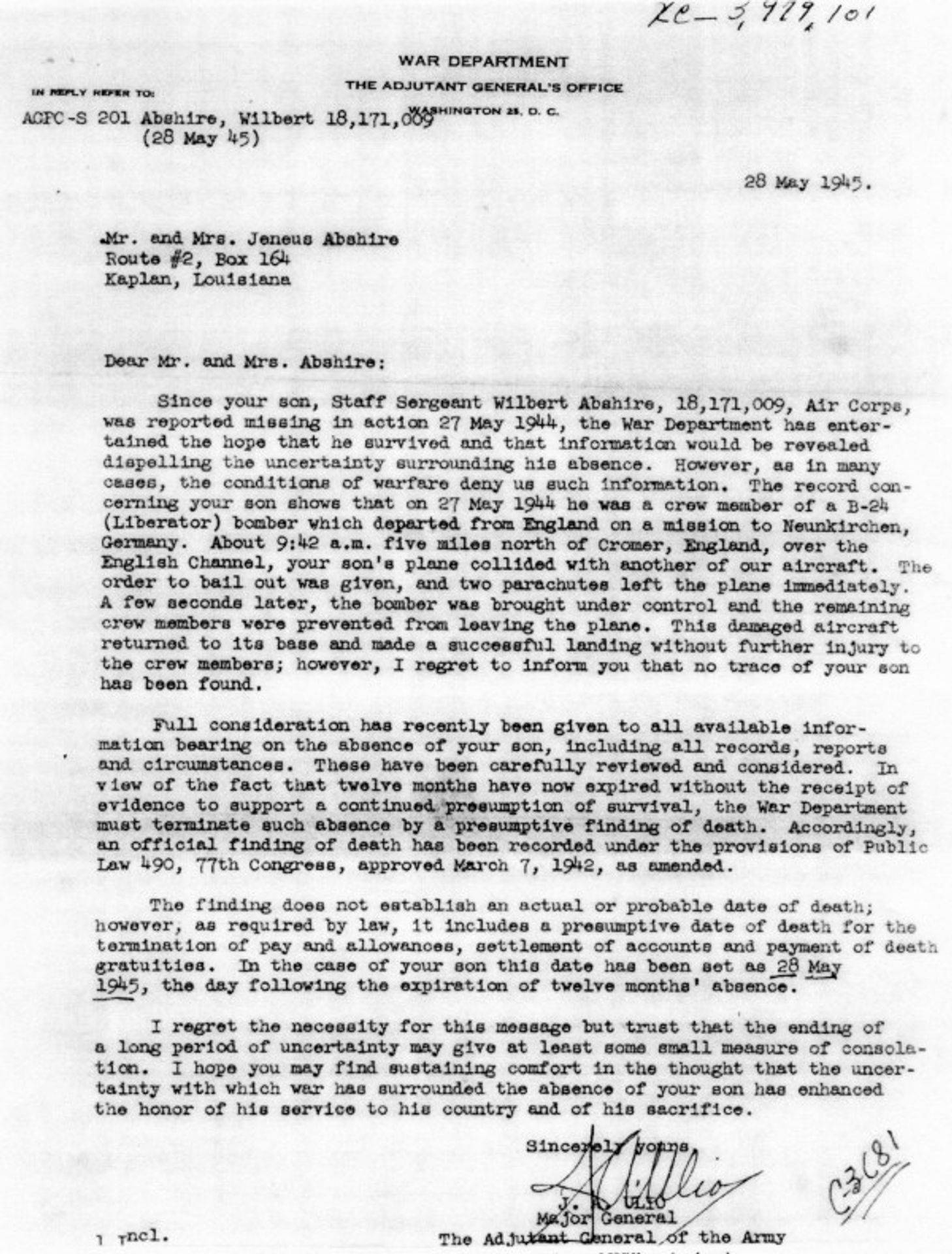Crew 75 – Assigned 755th Squadron – October 27, 1943
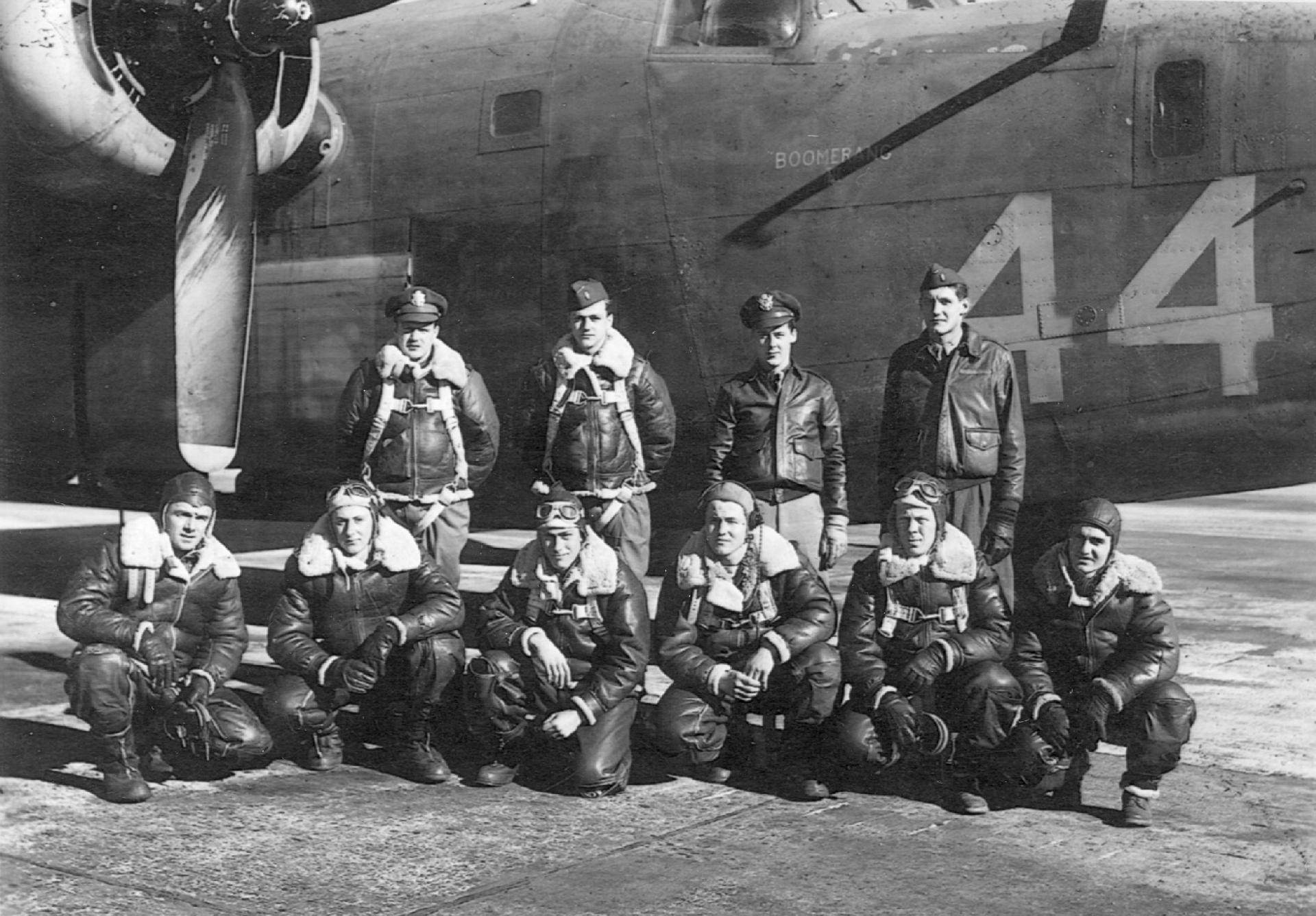
(Photo: Eve Doucet)
Completed Tour
| Rank | Name | Serial # | Crew Position | Date | Status | Comments |
|---|---|---|---|---|---|---|
| 1Lt | John P Mattson | 0661527 | Pilot | 04-Aug-44 | RFS | TD AAF 147 Indefinite period |
| 1Lt | Richard G Lind | 0693795 | Co-pilot | Jul-44 | CT | Awards - Distinguished Flying Cross |
| 1Lt | John I Woodworth | 0694908 | Navigator | Aug-44 | CT | Left for 8th AFRD at AAF 594 |
| 1Lt | Virgil K Boyum | 0751803 | Bombardier | Jul-44 | CT | Awards - Distinguished Flying Cross |
| T/Sgt | Graland O Meadows | 34500382 | Radio Operator | Aug-44 | CT | Left for 8th AFRD at AAF 594 |
| T/Sgt | August J Luft | 19060231 | Flight Engineer | 13-Jun-44 | CT | Awards - Distinguished Flying Cross |
| S/Sgt | Warren S Cohlmeyer | 17159867 | Aerial Gunner, 2/E | Jul-44 | CT | Awards - Distinguished Flying Cross |
| S/Sgt | Wilbert Abshire | 18171009 | Aerial Gunner, 2/E | 27-May-44 | KIA | Kaplan, LA |
| S/Sgt | Roy L Cassady | 35351363 | Aerial Gunner, 2/E | Aug-44 | CT | Left for 8th AFRD at AAF 594 |
| S/Sgt | Richard Ferguson | 35723314 | Aerial Gunner | May-44 | CT | Awards - Distinguished Flying Cross |
Crew 75 received their crew training at Tonopah, Nevada in the fall and winter of 1943. They flew the Southern Ferry route to the ETO in January 1944. They flew on the February 24th diversion mission to the Dutch Coast in support of the Eighth Air Force’s “Big Week”.
The crew’s first combat mission was on March 3, 1944. The target was Berlin, however the group was recalled due to weather. Mattson and crew were forced to abort this mission prior to the recall due to a leak in the pilot’s oxygen regulator. They were not given credit for this mission. 2Lt Frank Herzik and crew from the 755th Squadron were lost on this mission, presumably down in the frigid English Channel as nothing of plane or crew was ever found.
On March 6th the Eighth Air Force once more headed for Berlin. The 458th’s target was the Daimler-Benz Motor Werke near Genshagen. This was the first time that the Eighth Air Force had attacked Berlin in force and the Germans extracted a heavy price by downing 70 B-17’s and B-24’s. The 458th lost five Liberators and crews, the highest single mission loss the group would suffer while flying combat. Crew 75 flew a B-24H name Last Card Louie on this mission. At debriefing the crew reported no battle damage to their ship, but commented on seeing three B-24’s going down and reported attacks on their three ship element by a yellow-nosed ME-109.
All of this was apparently too much for John Mattson. According to John Woodworth, navigator, he [Mattson] “…went from the plane directly to the base hospital and from there to the ‘Flak House’. He was grounded and never flew again. Colonel Isbell kept him there for the rest of the war, doing some kind of office duty. Jim Olney [co-pilot Crew 61] was then assigned to our crew and he moved into the room with me that I had shared with Mattson.” Matson did remain with the 755th Squadron and eventually became the squadron supply officer and adjutant. Due to a ruptured eardrum on the raid on March 5, 1944, John Woodworth missed several missions with his crew. He would fly with Crew 75 until early June when they completed their tour. He was then moved to the lead crew of Capt Howard Slaton, in order to finish out his required missions.
There is a gap of one month between the time of Mattson’s removal from flying status and Olney’s first mission as pilot on April 5th. Records do not indicate the reason for this, but the flight record of Wilbert Abshire [missions listed below] indicate that at least some of the crew were still flying missions in this period, although it is not currently known who their pilot was. After April 5th, the crew’s missions can be tracked by Olney’s record. Olney took them on 23 missions between April 5th and June 4th when the crew flew their last mission. On 20 of these missions they flew B-24H-15-CF 41-29359 named Tail Wind. This aircraft was lost on August 5, 1944 when the Prevost Crew ditched in the Channel.
The pictures below show the crew upon their return from Berlin on April 29, 1944. 2Lt Virgil K. Boyum, bombardier, was credited with destroying an FW-190 from his nose turret, one of four aircraft shot down by the 755th Squadron alone on this date.
All but one member of Crew 75 completed their combat tour. On May 27, 1944, a scratch crew of enlisted was needed for a mission to Neunkirchen, Germany. S/Sgt Roy L. Cassady and S/Sgt Wilbert Abshire were represented from Crew 75 and they were both assigned to fly with 2Lt Lester C. Martin on a B-24J named Briney Marlin. This was Martin’s first mission as pilot. During assembly over the North Sea, about five miles north of Cromer, while making a left turn, Martin’s ship collided with another 755th Squadron B-24 piloted by 2Lt Howard J. Lobo and crew on their second mission. The entire tail assembly of Lobo’s ship was ripped off and they went spinning down into the under cast. All ten men were killed. The impact bent 8-10 feet of the right wing of Martin’s ship down at a 90° angle and put the ship into a spin. Martin rang the bail out bell and S/Sgt Chester R. Carlstrum (Crew 74), flying as engineer, opened the bomb bay, salvoed the bomb load and bailed out immediately. Abshire in the tail turret also bailed out, despite the urging of fellow crew members to wait. After losing several thousand feet, Martin and his co-pilot were somehow able to bring the plane under control and the bail out order was rescinded. Martin made a safe landing back at Horsham without further damage to the plane or injury to the crew. Carlstrum and Wilbert Abshire were never found.
Boise, Idaho 1943

(Photo: Eve Doucet)
Enlisted Men at Tonopah, NV – Fall 1943
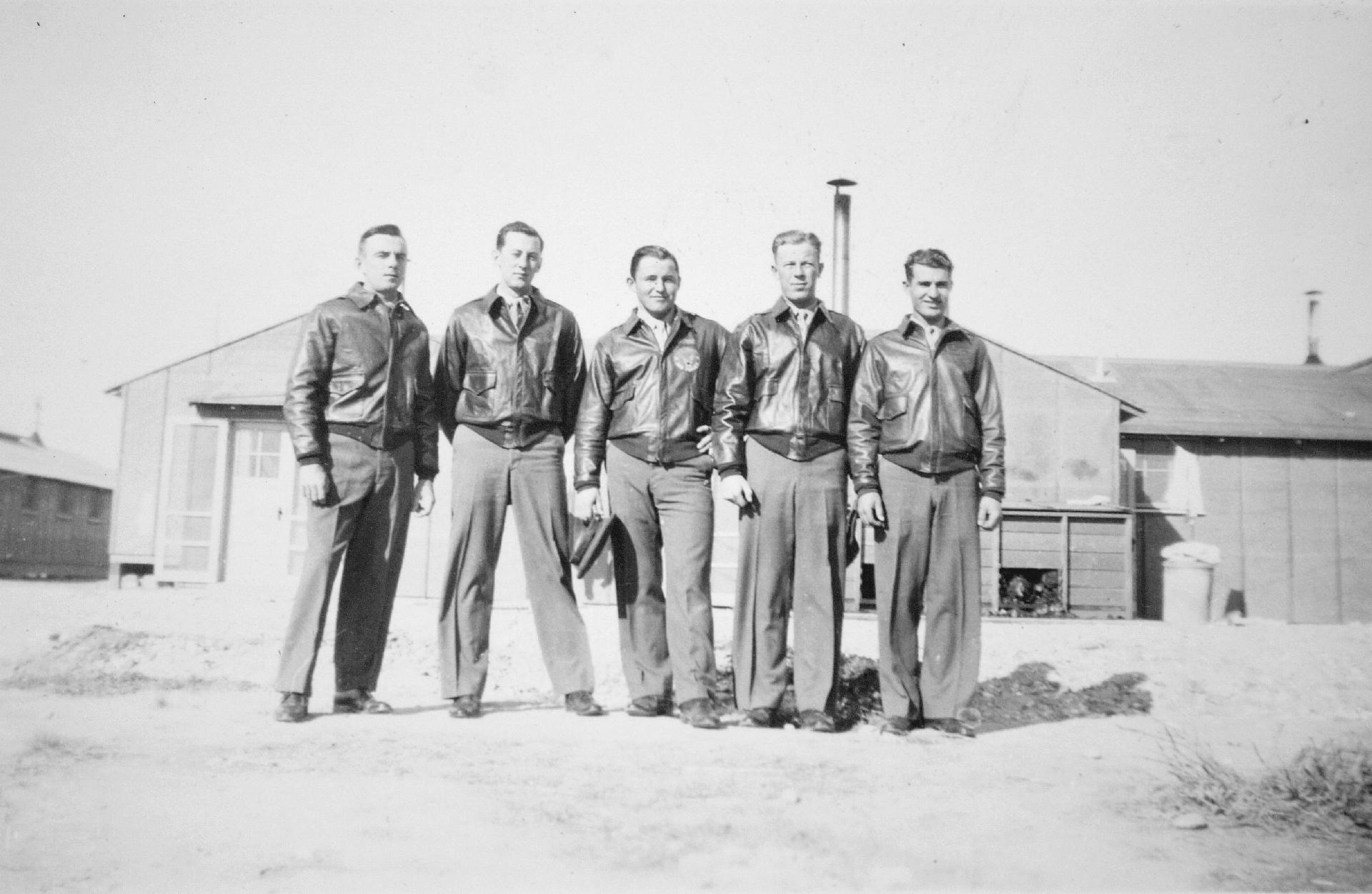
Wearing their A2 jackets (L-R): Richard Ferguson, Roy Cassady, Garland Meadows, Warren Cohlmeyer, August Luft

Decked out in flight gear (L-R): Richard Ferguson, Roy Cassady, Garland Meadows, Wilbert Abshire, Warren Cohlmeyer, August Luft
Missions – 1Lt John Mattson as Pilot
| Date | Target | 458th Msn | Pilot Msn | Serial | RCL | Sqdn | A/C Msn | A/C Name | Comments |
|---|---|---|---|---|---|---|---|---|---|
| 24-Feb-44 | DUTCH COAST | D1 | -- | 42-52441 | -- | J3 | D1 | LAST CARD LOUIE | Diversion Mission |
| 03-Mar-44 | BERLIN | 2 | ABT | 42-52441 | -- | J3 | 2 | LAST CARD LOUIE | PILOT OXY LEAK |
| 06-Mar-44 | BERLIN/GENSHAGEN | 4 | 1 | 42-52441 | I | J3 | 3 | LAST CARD LOUIE |
Missions – 1Lt James Olney as Pilot
| Date | Target | 458th Msn | Pilot Msn | Serial | RCL | Sqdn | A/C Msn | A/C Name | Comments |
|---|---|---|---|---|---|---|---|---|---|
| 05-Apr-44 | ST. POL-SIRACOURT | 16 | 1 | 41-29359 | J | J3 | 9 | TAIL WIND | |
| 08-Apr-44 | BRUNSWICK/WAGGUM | 17 | 2 | 41-29359 | J | J3 | 10 | TAIL WIND | |
| 10-Apr-44 | BOURGES A/F | 19 | 3 | 41-28706 | F | J4 | 6 | DREAM BOAT/SPARE PARTS | |
| 12-Apr-44 | OSCHERSLEBEN | REC | -- | 42-52441 | I | J3 | -- | LAST CARD LOUIE | RECALL |
| 19-Apr-44 | PADERBORN A/F | 23 | 4 | 41-29359 | J | J3 | 15 | TAIL WIND | |
| 20-Apr-44 | SIRACOURT | 24 | 5 | 41-29359 | J | J3 | 16 | TAIL WIND | |
| 24-Apr-44 | LEIPHEIM A/F | 26 | 6 | 41-29359 | J | J3 | 17 | TAIL WIND | |
| 26-Apr-44 | PADERBORN A/F | 28 | 7 | 41-29359 | J | J3 | 19 | TAIL WIND | |
| 27-Apr-44 | BONNIERES | 29 | 8 | 41-29359 | J | J3 | 20 | TAIL WIND | |
| 27-Apr-44 | BLAINVILLE-SUR-L'EAU M/Y | 30 | 9 | 41-29359 | J | J3 | 21 | TAIL WIND | |
| 29-Apr-44 | BERLIN | 31 | 10 | 41-29359 | J | J3 | 22 | TAIL WIND | |
| 01-May-44 | LIEGE M/Y | 33 | 11 | 41-28738 | O | Z5 | 16 | MEAT AROUND THE CORNER | |
| 07-May-44 | OSNABRUCK | 36 | 12 | 41-29359 | J | J3 | 24 | TAIL WIND | |
| 08-May-44 | BRUNSWICK | 37 | 13 | 41-29359 | J | J3 | 25 | TAIL WIND | |
| 19-May-44 | BRUNSWICK | 42 | 14 | 41-29359 | J | J3 | 28 | TAIL WIND | |
| 20-May-44 | RHEIMS A/D | 43 | ABT | 41-29359 | P | J3 | -- | TAIL WIND | ABORT - SEVERE ICING, GUNS |
| 21-May-44 | SIRACOURT | 44 | 15 | 41-29359 | J | J3 | 29 | TAIL WIND | |
| 23-May-44 | BOURGES | 45 | 16 | 41-29359 | J | J3 | 30 | TAIL WIND | |
| 24-May-44 | VILLEROCHE, near MELUN | 46 | 17 | 41-29359 | J | J3 | 31 | TAIL WIND | |
| 25-May-44 | MULHOUSE M/Y | 47 | 18 | 41-29359 | J | J3 | 32 | TAIL WIND | |
| 29-May-44 | TUTOW A/F | 50 | 19 | 41-29359 | J | J3 | 33 | TAIL WIND | |
| 30-May-44 | ZWISCHENAHN A/F | 51 | 20 | 41-29359 | J | J3 | 34 | TAIL WIND | |
| 31-May-44 | BERTRIX | 52 | 21 | 42-51110 | P | 7V | 6 | TOP O' THE MARK | |
| 02-Jun-44 | STELLA/PLAGE | 53 | 22 | 41-29359 | J | J3 | 35 | TAIL WIND | |
| 04-Jun-44 | BOURGES A/F | 54 | 23 | 41-29359 | J | J3 | 36 | TAIL WIND |
Crew 75 Pilots


2Lt John P. Mattson (left) was the first pilot of Crew 75. After the March 6, 1944 Berlin raid he turned in his wings and was reassigned in the 755th Squadron.
2Lt James E. Olney, co-pilot on Crew 61, was moved to Crew 75. His first mission as pilot was on April 5, 1944.
April 29, 1944 – Return from Berlin
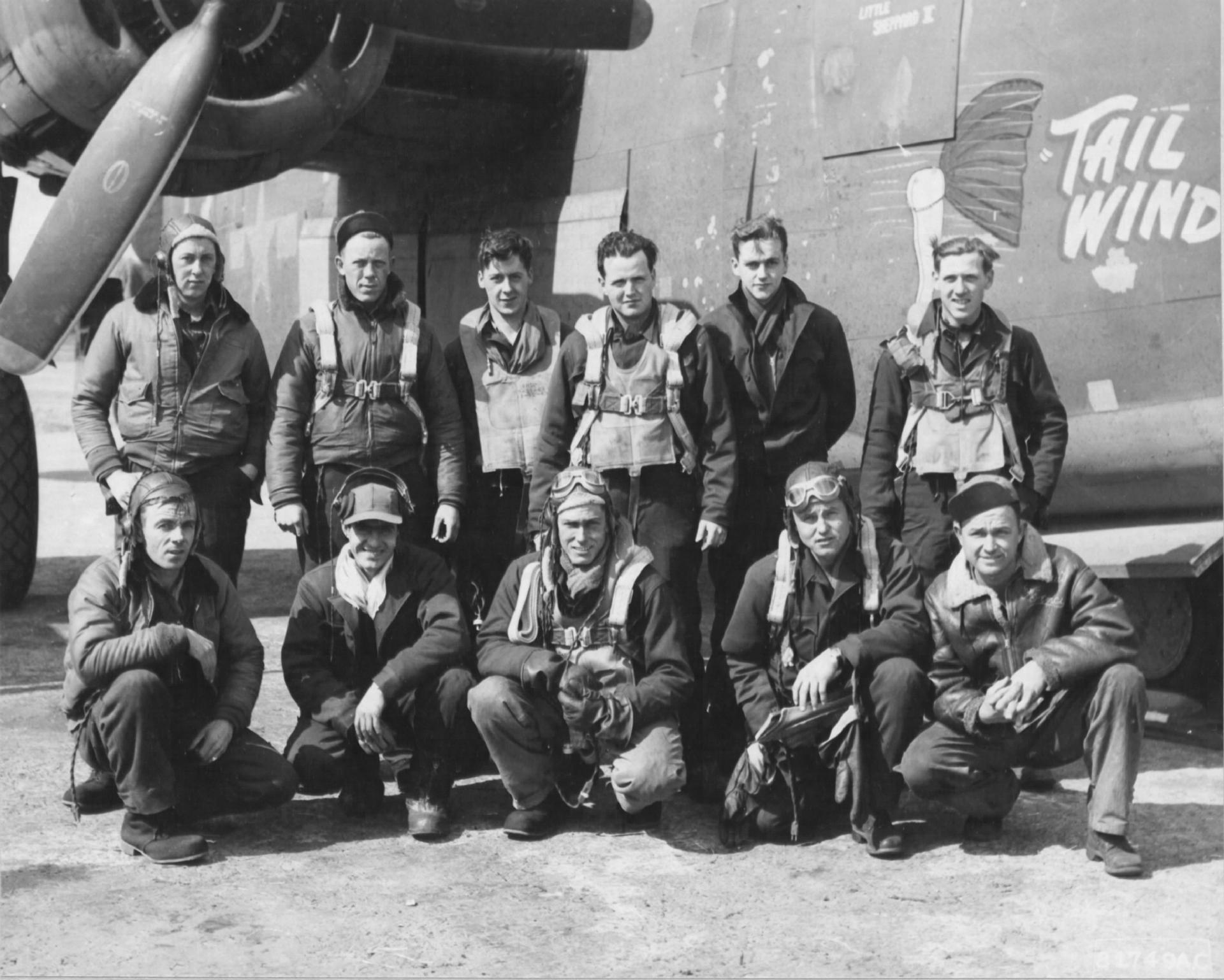
Front Row: Richard Ferguson, August Luft, Wilbert Abshire, Garland Meadows, M/Sgt John Carter (crew chief)

Photo Caption
“Back from an attack on Berlin, the faces of these men who battled the Luftwaffe for an hour and a half over central Germany tell something of the strain of battle they have just undergone. L to R – 2Lt Richard G. Lind, co-pilot, of 110 W. Hazeltine St., Kenmore, NY; 2Lt James E. Olney, pilot, of Watervliet, NY; SSgt Garland O. Meadows, radio operator, of Gainsborough, PA; and SSgt Wilbert Abshire, waist gunner of Crowley, LA. Their Liberator Tail Wind is in the background.”
S/Sgt Wilbert Abshire

Wilbert Abshire, the second child in the marriage of Jeneus Abshire and Alecia Simon, was born on May 23, 1920, and died in the prime of his life on May 27, 1944. He was an average student in school and graduated from Indian Bayou High School in 1938. He was active in school sports and was a good athlete. He was quiet, friendly, and easy going, yet very competitive. As he became a teenager, he enjoyed partying and was fairly popular with the girls. He liked his beer, and relatives said he took after his grandfather Simon in this regard.
Several incidents that occurred during Wilbert’s growing years are worthy of mention. While assisting his little friends build a fort using old corn stalks, he was stung by a poisonous spider. He was sick for several weeks, even though he was treated by the best “traiteur” in the area.
One dark night Wilbert and [his brother] Allison were returning from their Grandpa Simon’s store. They were both scared and were each carrying a stick for protection. As they passed by some bushes near their uncle’s house, a white ghost-like figure jumped out of the bushes. Wilbert threw his stick and hit the “ghost” in the head. It turned out to be their Uncle Maurice under a white sheet. He never tried to scare them after that.
A few years later, Wilbert was hit in the face by a baseball bat that slipped out of the hands of a batter while the batter was swinging at a pitched ball. He was knocked unconscious and bled profusely, but he soon recovered.
In another incident, Wilbert came close to drowning. He, Allison, and a couple of young friend were on their way home after delivering the “Grit” newspaper in the countryside. It had been raining and water was rising in all drainage ditches. When they arrived at a canal draining into the Bayou Queue de Tortue, the water was high and the current was swift. Not wanting to walk upstream a half mile or so where the water would not be so deep, Wilbert decided to attempt swimming across the approximately twenty-foot width of the canal. When he got half-way across, the current was so strong that it started pushing him into the bayou. Luckily, he was able to grab the branch of a Willow tree growing in the ditch on the opposite side and pull him to safety.
After finishing high school, Wilbert enrolled in Southwestern Louisiana Institute, now the University of Southwestern Louisiana. After a few months he became discouraged due to lack of sufficient work and student aid to meet his college expenses, and he dropped out. He returned home to help on the family farm where he was considered a good worker.
On January 5, 1940, Wilbert enlisted in the Civilian Conservation Corps. This was a federal program which provided training and temporary employment for young men from poor families who could not afford the cost of training nor find employment due to the lingering national depression. The program was usually referred to as the “C C Camps,” and the participants lived in army type barracks or camps. Members performed conservation type work such as planting trees.
On the day of his enlistments at the camps in Abbeville, records show that Wilbert was 19 years of age, had brown hair and eyes, Fair Complexion, Five feet nine inches in height, and his previous work experience was listed as farm laborer.
After orientation at the Abbeville camp, he was transferred to the camp in Farmerville, Louisiana, for training as a radio operator. This training consisted of learning to type and to send and receive the Morse Code. Upon completion of this training he was sent to the camp in Leesville, Louisiana, as the radio operator. After two months there, he was able to get transferred back to the Abbeville camp where he operated the camp canteen and was the pitcher on the camp’s softball team. He was honorably discharged from the Civilian Conservation Corps on June 14, 1942, and returned home to help harvest the farm crops for that year.
World War II had started and young men were enlisted or being drafted for military services. Wilbert tried to enlist in the Army Air Force, but he was underweight. He was told to get plenty of rest, eat well, drink plenty of milk and try again in a few weeks. This he did and was able to pass the physical examination.
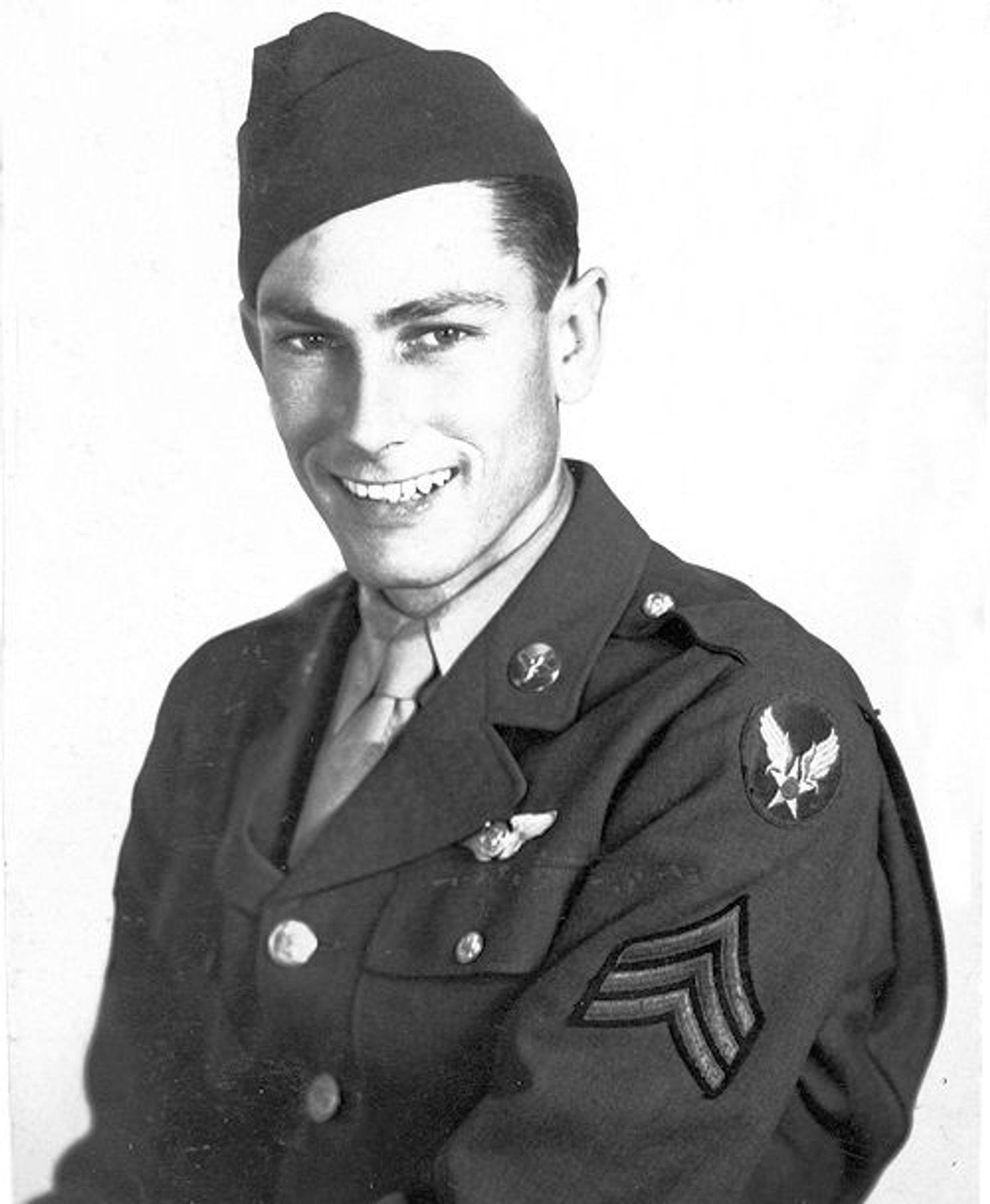
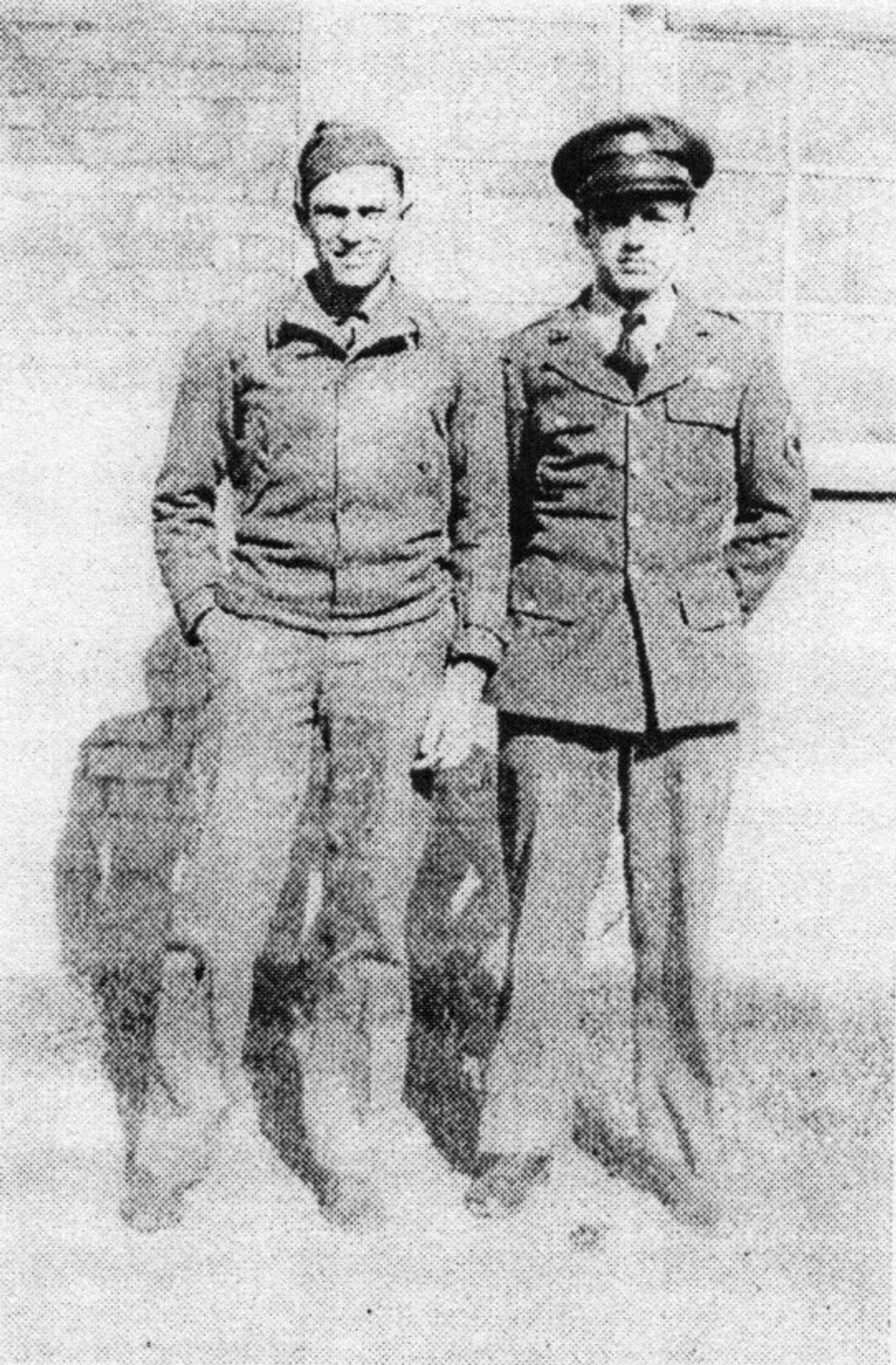
Wilbert and his cousin Loveless Simon (photo at left) joined the Army Air Force together in early 1943. They reported to the U.S Army Air Force Field in Lake Charles, Louisiana, for basic training. After completion of basic training, Wilbert was sent to Keesler Field near Biloxi, Mississippi, for further training.
At Keesler he received training in the service and maintenance of B-24 Liberator bombers. One weekend while at Keesler he attempted to come home. This was a distance further from base than he was permitted to travel. He was stopped by the military police and returned to his base. This infraction of a military rule cased him to lose the one stripe he had earned upon completion of basic training.
After completing the training at Keesler in July 1943, Wilbert was sent to the Laredo Army Air Field Flexible Gunnery School near Laredo, Texas. He was stationed at this school through September 1943. Upon completion of this training he made Sergeant. He next completed two short-term training assignments at Gowen Army Air Filed in Boise, Idaho, for special flight training and ground school for assistant engineers.
Upon completion of these two assignments in November 1943, he was given several days leave, and went to San Francisco to enjoy the city. While there he visited Claire, Milton’s wife, and Susan, their baby daughter. He was Susan’s Godfather. At Claire’s urging, he had his picture taken in military uniform.
Upon completing his furlough, Wilbert reported to the Army Air Force Bombing and Gunnery Range near Tonopah, Nevada. He became a crew member of a B-24 Liberator bomber assigned to the 755th Squadron, 458th Group, and 96th Wing of the 8th U.S Air Force. At this bombing and gunnery range in Nevada, he received intensive practical training through January 1944.
Their training completed in the United States, the members of the 458th Bomb Group, prepared for departure to England for combat duty. The ground echelon traveled by rail and then by ship. The aircrews flew to Hamilton Field, California, to pick up new B-24s. They flew their “Liberators” to England via Brazil and West Africa, joining the group’s support elements at what was to become their home base on February 18, 1944.
Their new base of operation was Army Air Force Station 123, Horsham St. Faith, Norfolk County, England. Additional personnel training and aircraft modifications began immediately as the group prepared for its coming aerial battles. The Allied invasion of Europe was fast approaching, and Germany and the occupied countries of Europe were being bombed night and day. The Americans were making day-time raids which were particularly dangerous.
On March 6, 1944, the 458th Group took part in the first bombing mission the 8th Air Force completed on Berlin. This was Wilbert’s first combat mission. In addition to this mission on March 6, his individual flight record shows that he participated in bombing missions on the following dates: March 8, 15, 23, 24, 27, and 28; April 5, 8, 10, 13, 24, 25, 26, 27, 28, and 29; and May 1,7 8, 19, 21, 23, 24, and 25.
From March 6 through May 25, a few days more than two and one-half months, Wilbert completed 25 bombing missions. During this period of time he also spent a week on furlough in London, was promoted to Staff Sergeant, and observed his 24th Birthday.
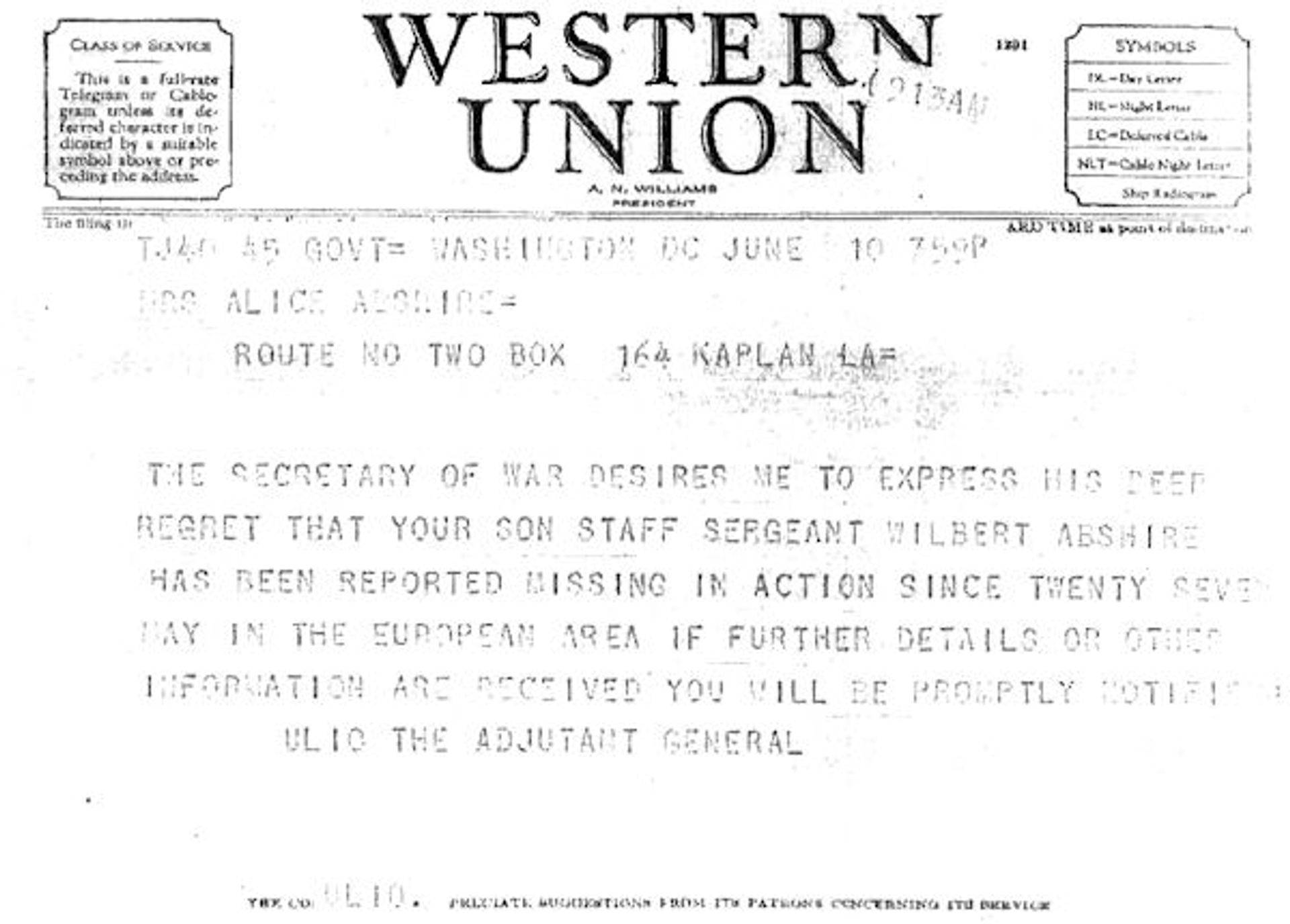
On May 27, 1944, Wilbert set out on his 26th bombing mission heading for Neunkirchen, Germany. As the planes were getting into their assigned positions in their flight formation, another plane collided with the plane Wilbert was in, and it appeared his plane would go down. The order to bail out was given, and two parachutes left the plane immediately. It was Wilbert and another crew member [S/Sgt Chester R. Carlstrum from Crew 74]. A few seconds later, their plane was brought under control, and the order to stop bailing out was given, thus preventing others from leaving the plane.
The damaged plane returned to its base and made a successful landing without further injury to the crew members. The other plane involved in the collision received minor damage and continued on the mission. [This other plane, piloted by 2Lt Howard Lobo, was actually lost with all ten crew members]. The tragedy occurred at 9:42 a.m. on May 27, 1944, over English Channel five miles north of Cromer, England.
Wilbert was classified as Missing In Action for a year and then declared dead (click letter at right for larger image). He was awarded the Air Medal with three Oak Leaf Clusters and the Purple Heart Medal posthumously. His untimely death was a shock to his family, friends, and his sweetheart. His parents grieved over his death for the rest of their lives.
The base Wilbert was flying from was near Norwich, England. In 1963 a Memorial Room was dedicated in the Central Library there in memory of the American stationed in the area who lost their lives during the war. A Book of Remembrance containing the names of the deceased servicemen is kept in the library. In 1965 Wilbert’s brother Allison and two of Allison’s children, Gail and Alan, visited the library and found Wilbert’s name in the book.
At the American Military Cemetery in Cambridge, England, is the Wall of the Missing containing the names of over 5,000 service men declared as Missing In Action during World War II. Gail visited this cemetery in 1993 and saw her Uncle Wilbert’s name in this wall.
From the Abshire Family history (Section XI) — Eve Abshire Doucet

